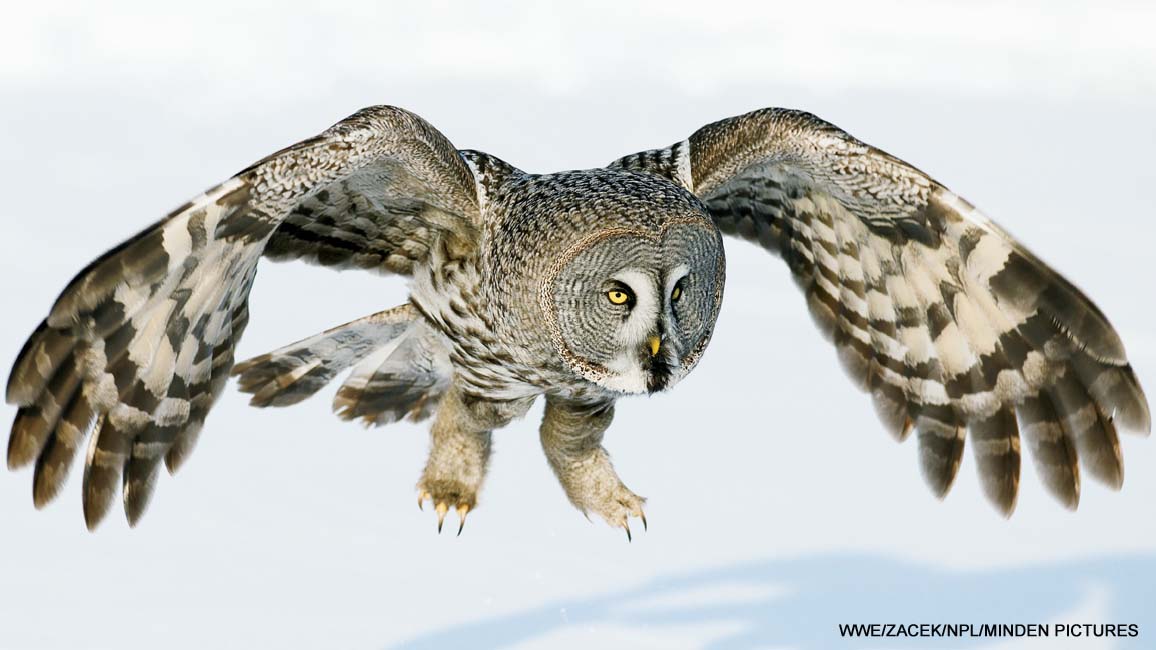
Who Knows Owls?
By Ellen LambethBy the time you’ve flapped through these pages, yooou will know owls! Start below to discover what makes an owl an owl.
Soft, fluffy feathers muffle the sound of air passing over a flying owl’s body. Even the flap-ping wings are silent, thanks to soft, comb-like edges on the stiff flight feathers. All the better for the owl to hear and sneak up on prey.
The claws (called talons) are curved and very sharp—perfect for striking, killing, and gripping prey.
The feathers on the face form a facial disc. It’s shaped like a satellite dish to collect sounds and channel them to the ears.
The bill is curved and sharp, which is good for ripping apart large prey. It also doesn’t stick far out in front of the face. That way, it can’t block sights and sounds from reaching the bird’s eyes and ears.
An owl’s huge eyes provide excellent vision—day or night. Both face forward, making it easier to focus on prey and tell exactly how far away it is.
Owl ears are hidden under feathers behind the eyes. They’re sensitive enough to pick up the tiniest sounds from prey. That lets an owl hunt in near total darkness.
THE NATURE OF OWLS
You probably know that most owls are nocturnal (active at night). But not all of them. A few prefer to be out at dawn and dusk—others in broad daylight. Here are some more owl notes of interest.
On the Decline: Some owl species are endangered or at risk. This northern spotted owl is one of them. It lives only in old forests of the Pacific Northwest. But these forests are being cut down for lumber. To make matters worse, barred owls—a related species that survives more easily there—are taking over the forests that are left.
Owl Puke: Depending on what kind it is, an owl may eat anything from insects, fish, or lizards to other birds or mammals. It usually swallows its prey whole. But the stuff the stomach can’t digest—such as fur, feathers, bones, and teeth—gets packed together in an owl pellet. After a meal, the owl throws up the pellet. By picking a pellet apart, you can figure out what the owl had eaten.
Bobblehead: Owls can’t move their eyes the way you can. Instead, they move their whole heads. They use their very flexible necks to bob their heads, tilt them nearly upside down, or twist them almost all the way around.
This northern pygmy owl even has feathers that look like fake eyes on the back of its head! A predator about to attack from behind may change its mind, thinking it’s being watched.
Fuzzy Wuzzy: What could be cuter than a fuzzy owl chick, called an owlet? Two owlets! These are tawny owls. When they first hatched, Mom stayed in the nest with them while Dad brought in meals for everybody. Now, they’ve moved out onto a branch but still can’t fly yet. They wait patiently for the folks to deliver some take-out food.
WHO’S WHOO?
There are about 250 species of owls across the globe. They look different, sound different, and live in different habitats. Meet just a few of them here.
Nature Note
More owls you might easily come across in the United States are the great horned owl, barred owl, and barn owl. Look for these and others online or in a field guide—and then in your own neighborhood.
The Eurasian eagle owl shares the honor of World’s Largest Owl with the Blakiston’s fish owl of Asia. It stands about as tall as a collie.
Note the “ears” or “horns,” which are really just tufts of feathers. Along with the bird’s colors, they help this owl blend in with its forest surroundings. Since the bird can raise and lower the tufts, they may also let the owl send messages to other owls.
A screech owl is about the size of a very fluffy robin. In the United States, there are a western species and an eastern one. They can be found almost anywhere, from forests to fields and from suburbs to towns. They don’t screech, though. Their trilling call is more like a whistle or whinny.
Probably everyone recognizes the snowy owl. That’s what Harry Potter’s Hedwig is. Snowies are the heaviest owls in North America. And their feathers match the snowy, open landscape in their home in the Far North. In winter, snowy owls sometimes travel down to the “lower 48” states for a better chance at finding food.
The elf owl of the American Southwest and Mexico lives up to its name. Small enough to fit in the palm of your hand, it wins the title of World’s Smallest Owl.
The cute little burrowing owl was made famous by a children’s book (and movie) titled Hoot. As you might guess by its name, this owl nests underground, which is odd for any bird. And it’s active just about any time of day or night. Also unlike other owls, it often hangs out in colonies.
“Whoo Knows Owls?” originally appeared in the November 2015 issue of Ranger Rick magazine.
(Click on each image above for a closer view of the story.)



















